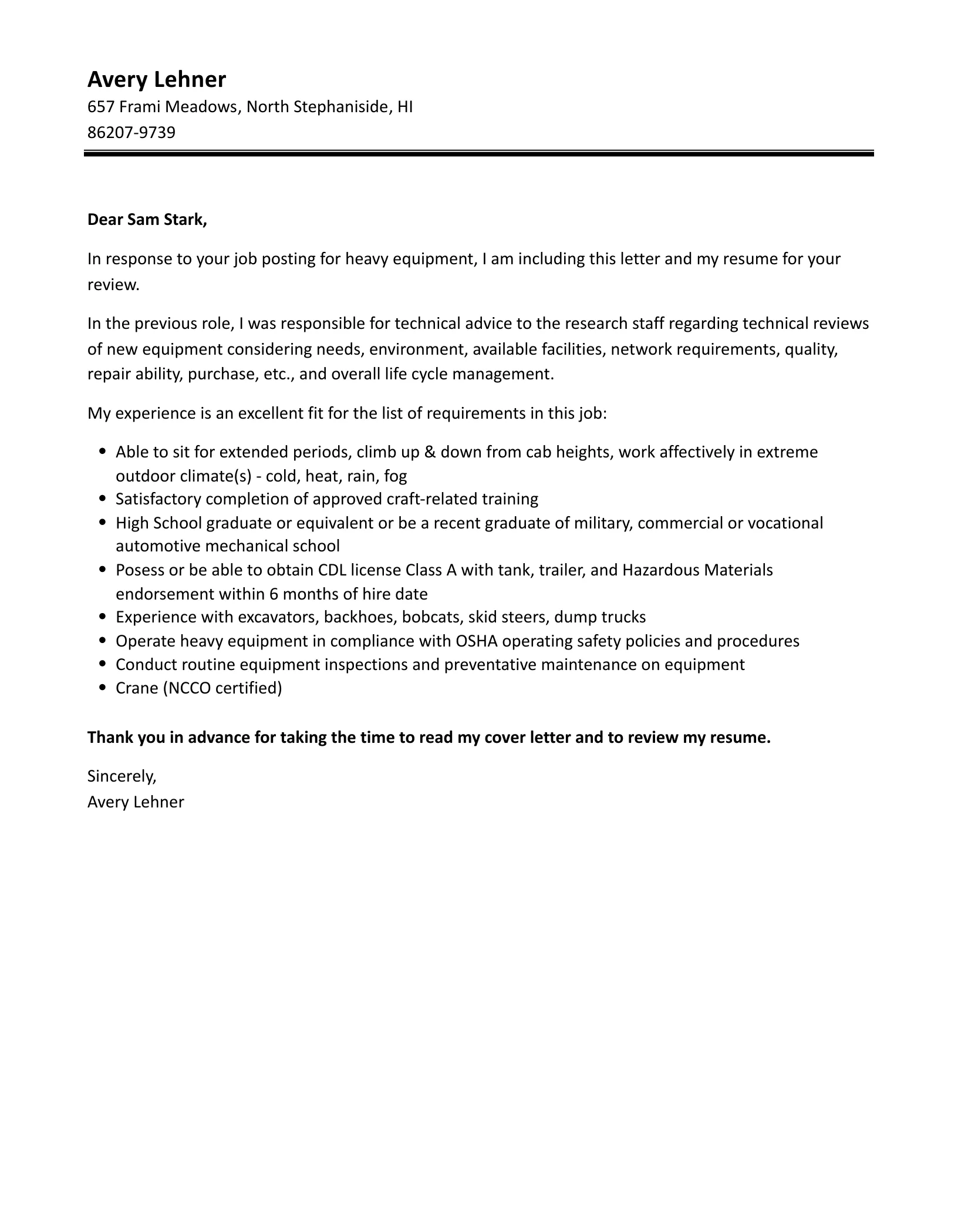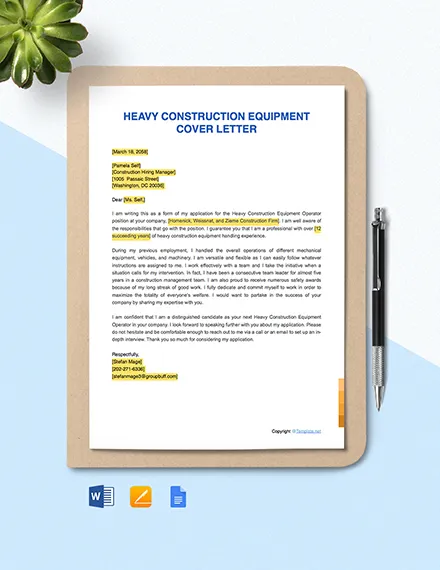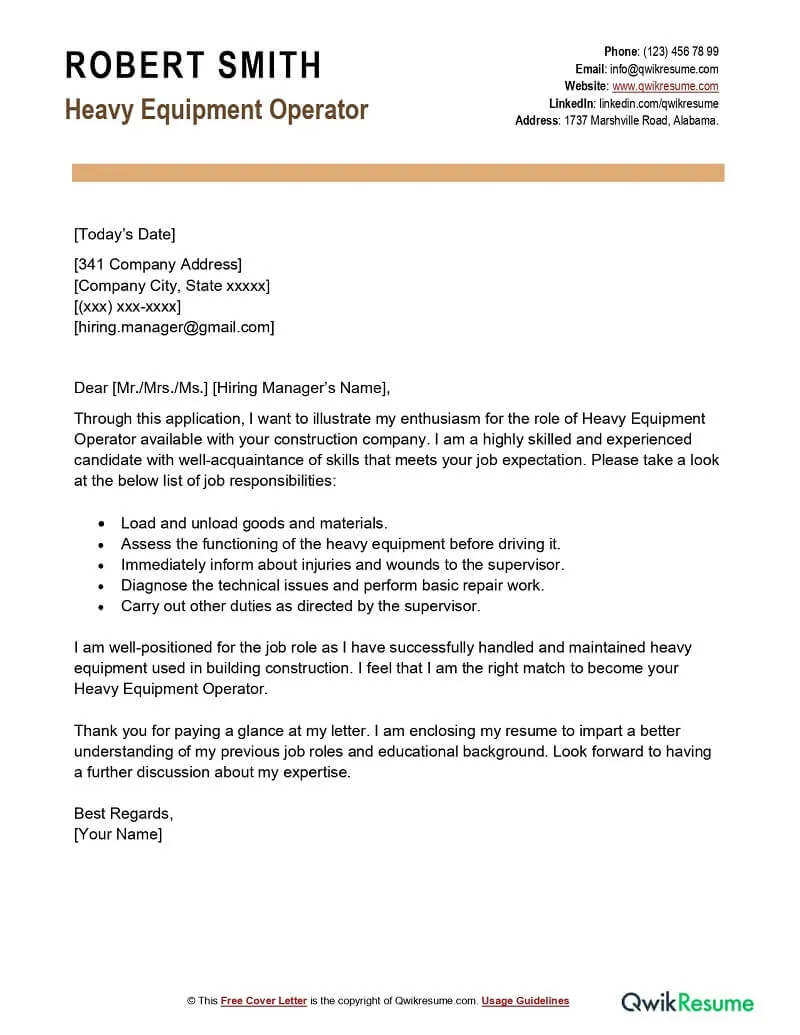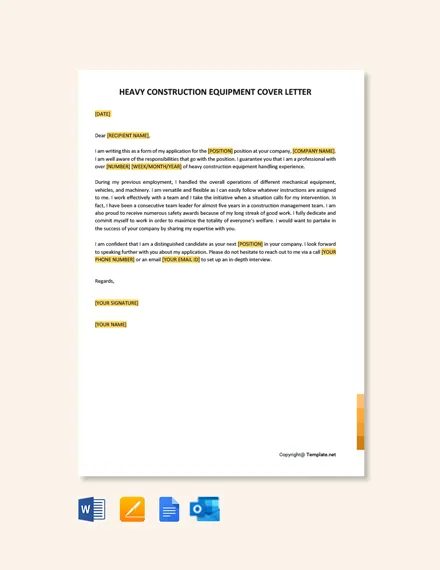Why You Need a Standout Operator Cover Letter
In the competitive field of heavy equipment operation, a well-crafted cover letter is your first opportunity to make a strong impression and secure your dream job. It is not just a formality; it’s a crucial tool that sets you apart from other applicants. A generic resume often blends in, but a personalized cover letter allows you to highlight your specific skills, experience, and enthusiasm for the role, making a convincing case for why you are the best fit. Think of it as your personal introduction to the hiring manager, providing context and depth to your qualifications that a resume alone cannot convey. By taking the time to create a compelling cover letter, you significantly increase your chances of getting noticed and moving forward in the hiring process. This is your chance to show that you’re not just a qualified operator but also a proactive and detail-oriented professional.
What to Include in Your Cover Letter
A successful cover letter for a heavy equipment operator should provide all the essential information and some optional details. It serves as a companion document to your resume and should expand upon your qualifications. Begin with your contact information and the hiring manager’s details. In the opening paragraph, make a strong statement about why you’re writing. Your core content should highlight your relevant skills and experience, specifically mentioning the types of equipment you can operate. Provide quantifiable achievements that show your value, such as projects completed, safety records, or efficiency improvements. Demonstrate your enthusiasm for the role and the company. Conclude with a call to action and, as a final touch, proofread and format your letter to ensure it presents you professionally. This ensures your application stands out from the crowd.
Your Contact Information

At the top of your cover letter, begin with your contact information. This section should clearly display your full name, address, phone number, and email address. Make sure the email address is professional; avoid using nicknames or informal language. This information is essential for the hiring manager to easily contact you if they want to learn more about your qualifications or to schedule an interview. Accuracy here is key. Double-check all details to ensure they are correct. This simple yet crucial step ensures that you can be reached promptly. You are making it easy for the hiring manager to get in touch and move you forward to the next step of the hiring process, starting with this foundational element enhances the credibility of your application and reflects your attention to detail.
The Hiring Manager’s Information
Addressing the hiring manager by name shows that you have taken the initiative to research the company and personalize your application. If the name of the hiring manager is available, include their name and title. If the name isn’t available, research the company website, LinkedIn, or even call the company to find out. This shows professionalism and a genuine interest in the position. If you are unable to find a specific name, using a generic title like ‘Hiring Manager’ or ‘Recruiting Team’ is acceptable, but it’s always best to personalize it. Including this information demonstrates your attention to detail and your commitment to making a strong first impression. This small step can make your cover letter feel less generic and more tailored to the specific opportunity, increasing your chances of getting noticed.
A Compelling Opening
The opening paragraph of your cover letter is your chance to capture the hiring manager’s attention. Start with a strong statement that immediately grabs their interest. Briefly state the position you are applying for and where you saw the job posting. Then, use this opportunity to highlight your most relevant skills or a key achievement that aligns with the job requirements. For example, you could mention your years of experience, any certifications, or a specific project you successfully completed. The opening should clearly state why you are the perfect candidate. Avoid generic phrases; instead, show enthusiasm and immediately demonstrate your value to the company. A well-crafted opening sets the tone for the rest of your letter and encourages the hiring manager to continue reading. Make it memorable and showcase your professionalism from the very first sentence.
Highlighting Your Skills and Experience

The body of your cover letter is where you showcase your skills and experience in detail. Focus on the most relevant qualifications mentioned in the job description. Provide specific examples of how you have used your skills in past roles. Describe your experience operating different types of heavy equipment, such as excavators, bulldozers, loaders, and graders. Briefly explain your responsibilities and accomplishments in each role. Quantify your achievements whenever possible; use numbers to show the impact of your work. For instance, you could mention the number of projects completed, the amount of material moved, or any safety improvements you contributed to. Show how your skills align with the company’s needs and the specific requirements of the job. This section is crucial for demonstrating that you possess the necessary expertise to excel in the role.
Mentioning Specific Equipment
When listing your experience, be as specific as possible about the equipment you have operated. Hiring managers want to know exactly what you are proficient in. Include the makes and models of the equipment you are familiar with, such as Caterpillar, John Deere, Komatsu, or Volvo. This shows that you are an experienced operator who can handle different types of machinery. If you have experience with specialized equipment, such as those used in mining, construction, or forestry, be sure to mention it. Also, include any relevant certifications or licenses that demonstrate your ability to operate these machines safely. This specificity assures the employer that you have the right skills and experience to operate the equipment needed for the job.
Quantifying Your Achievements
One of the most effective ways to make your cover letter stand out is by quantifying your achievements. Instead of simply stating that you are a skilled operator, provide specific numbers to demonstrate your value. Use metrics to illustrate your accomplishments. For example, mention how much you increased efficiency or how you minimized downtime through your actions. Did you reduce fuel consumption by a certain percentage? Did you complete projects ahead of schedule or under budget? Include any metrics that show your contributions and how you made a positive impact in your previous roles. These numbers will make your accomplishments more tangible and demonstrate your ability to deliver results. Quantifying your achievements provides concrete evidence of your value to the employer and sets you apart from other applicants.
Showcasing Your Safety Record

Safety is paramount in the heavy equipment operation industry, so be sure to highlight your safety record. Mention any safety certifications or training you have completed, such as OSHA certifications. If you have received any safety awards or commendations, include them. It is important to show that you are committed to safe operating practices and have a clean safety record. Emphasize your ability to follow safety protocols and your dedication to preventing accidents. Being a safe operator is essential to the company’s operations. Including this information also demonstrates your commitment to the company’s values. Your safety record is a critical factor in your application; it assures the hiring manager that you are a responsible and reliable candidate.
Expressing Enthusiasm and Interest
In your cover letter, express your enthusiasm for the position and the company. Briefly explain why you are interested in working for them, specifically. Do some research on the company and mention something that resonates with you. This could be their reputation, their projects, their values, or their commitment to safety. Showing genuine interest sets you apart and makes you more memorable. Tailor your letter to the specific job. Avoid generic statements and show the hiring manager that you have carefully considered the opportunity. This is your chance to show you are not just looking for a job but want to contribute to the company’s success. Expressing your enthusiasm demonstrates you are motivated and eager to take on new challenges.
Call to Action
End your cover letter with a clear call to action. State your interest in an interview and how you are available. Make it easy for the hiring manager to contact you by reiterating your contact information. Thank the hiring manager for their time and consideration. A strong call to action encourages the reader to take the next step. Be confident and professional. Reiterate your enthusiasm for the role and your belief that you are a good fit for the company. This final touch makes it clear that you are serious about the opportunity and are eager to take the next step in the hiring process. This simple step makes a significant difference and can help you get the job.
Proofreading and Editing

Before submitting your cover letter, carefully proofread and edit it. Errors can undermine your credibility. Check for any grammatical errors, spelling mistakes, and punctuation errors. Ensure the language is clear, concise, and professional. Have someone else review your letter as well; a fresh pair of eyes can often catch mistakes you might have missed. A well-written, error-free cover letter shows your attention to detail. Your cover letter reflects your commitment to professionalism. It shows that you pay attention to detail and are dedicated to presenting yourself in the best possible way. Thorough proofreading is essential to avoid making a negative impression. Ensure that your cover letter is perfect before sending it.
Formatting Your Cover Letter
The formatting of your cover letter is just as important as the content. Use a professional font, such as Times New Roman, Arial, or Calibri, in a readable size (11 or 12 points). Use standard margins (1 inch on all sides) and single spacing. Keep the letter concise and easy to read, with clear paragraphs and headings. Use bullet points or numbered lists to highlight your skills and achievements, when appropriate. Save your cover letter as a PDF file to preserve the formatting and ensure that the hiring manager can view it correctly. Proper formatting is crucial for making a professional first impression. It makes your cover letter easy to read and demonstrates your attention to detail. A well-formatted cover letter shows that you care about presenting yourself in the best possible light.
